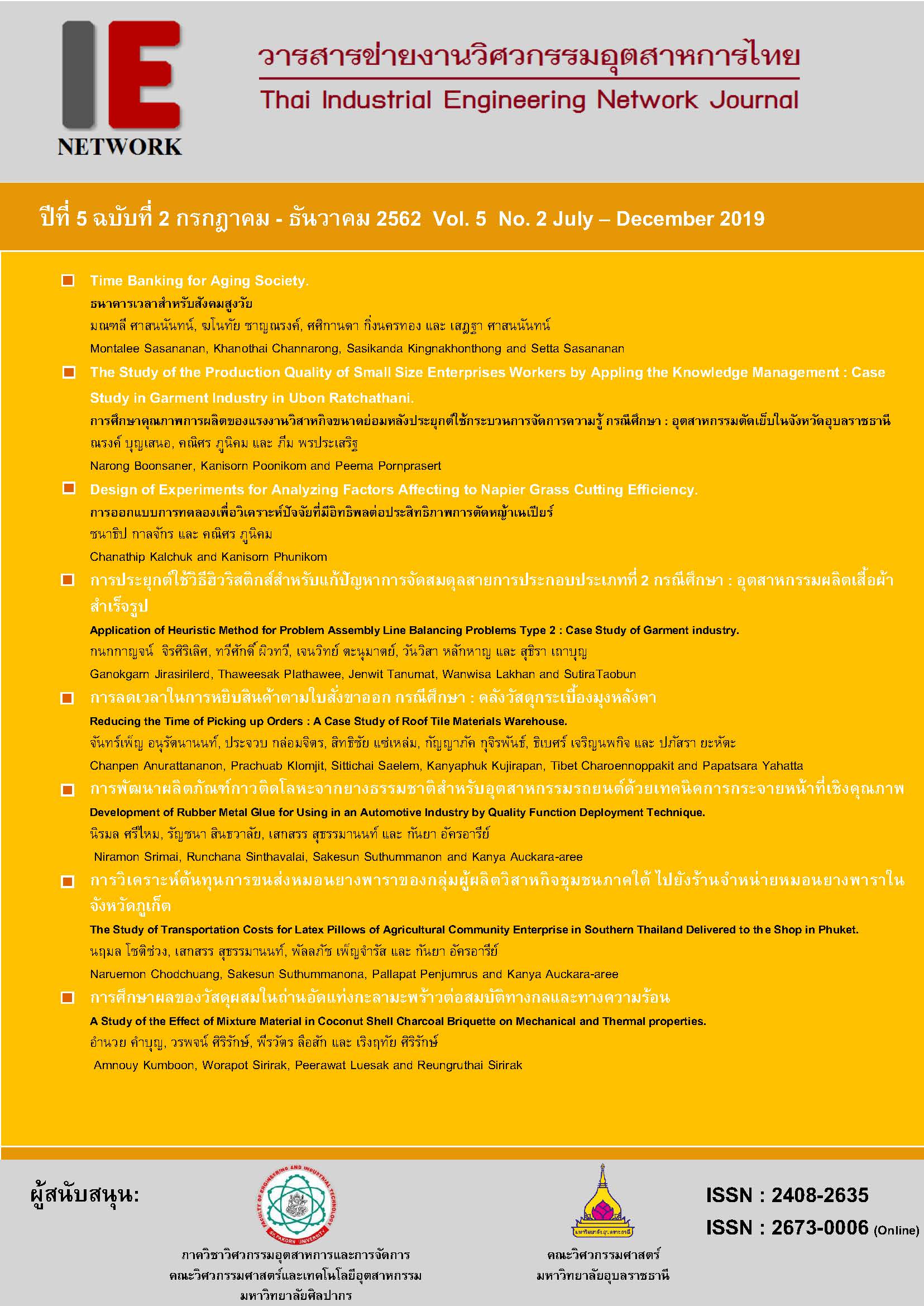A Study of the Effect of Mixture Material in Coconut Shell Charcoal Briquette on Mechanical and Thermal property
Main Article Content
Abstract
The objective of this research was to study the mechanical and thermal properties of the coconut shell charcoal briquette. The charcoal briquettes were prepared from charcoal powders mixed with an agricultural waste or community enterprise residues such as corn tree peanut shell and egg shell. The 20%wt latex glue of total raw material weight was used as a binder. After that, the 8 experimental conditions were designed for the charcoal briquettes properties study such as compressive resistance, bending resistance moisture and heat energy. From the research, it was found that the prepared charcoal briquettes from the mixture of coconut shell charcoal powders, corn tree and peanut shell at 50:25:25 exhibited 5.678 kN/mm2 of the average compressive resistance, 1.125 kN/mm2 of the average bending resistance, 5.596% of the average moisture and 5,515.33 Cal/g of the highest heat energy, respectively. Therefore, these results indicated that this condition was an appropriate condition in the application. Afterward, an ANOVA method was applied in the statistical variance analysis at significance level 0.05 of compressive resistance, bending resistance, moisture and heat energy. The results present a significant difference of the 8 experimental conditions.
Article Details
บทความ ข้อมูล เนื้อหา รูปภาพ ฯลฯ ที่ได้รับการตีพิมพ์ในวารสารฯ ถือเป็นลิขสิทธิ์ของวารสารฯ หากบุคคลหรือหน่วยงานใดต้องการนำทั้งหมดหรือส่วนหนึ่งส่วนใดไปเผยแพร่ต่อหรือเพื่อกระทำการใดๆ จะได้รับอนุญาต แต่ห้ามนำไปใช้เพื่่อประโยชน์ทางธุรกิจ และห้ามดัดแปลง
References
[2] หทัยนุช จันทร์ชัยภูมิ, "ถ่านอัดแท่งจากเปลือกมะขาม," in การประชุมวิชาการและนำเสนอผลงานวิจัยระดับชาติ ราชธานีวิชาการ ครั้งที่ 3, อุบลราชธานี, 2561.
[3] S. Wu and S. Zhang, "High-strength charcoal briquette preparation from hydrothermal pretreated biomass wastes," Fuel Processing Technology, vol. 171, p. 293–300, 2018.
[4] C. A. I. Raju, K. Ramya Jyothi, M. Satya and U. Praveena, "Studies on development of fuel briquettes for household and industrial purpose," International Journal of Research in Engineering and Technology, vol. 3, no. 2, pp. 54-63, 2014.
[5] ลดาวัลย์ วัฒนะจีระ, ณรงค์ศักดิ์ ลาปัน, วิภาวดี ชัชวาลย์ และ อานันท์ ธัญญเจริญ, "การพัฒนาก้อนเชื้อเพลิงชีวมวลจากเศษฟางข้าวผสมเศษลำไยเหลือทิ้ง," วารสารวิจัยและพัฒนา มจธ., ปีที่ 39, ฉบับที่ 2, หน้า. 239-255, 2559.
[6] สุวดี จางอิสระกุล, อับดุลลาตีฟ ดอรอแม, อาริษา เรืองมี และ ชญานุช แสงวิเชียร, "ชีวมวลทางเลือกใหม่สำหรับพลังงานทดแทนโดยเปลือกลูกยางและหญ้าแฝก," in การประชุมวิชาการเครือข่ายพลังงานแห่งประเทศไทยครั้งที่ 5, พิษณุโลก, 2552.
[7] นฤภัทร ตั้งมั่นคงวรกูล และ พัชรี ปรีดาสุริยะชัย, "การศึกษากากกาแฟและกากชามาใช้ประโยชน์ในรูปเชื้อเพลิงอัดแท่ง," วารสารมหาวิทยาลัยศรีนครินทรวิโรฒ (สาขาวิทยาศาสตร์และเทคโนโลยี), ปีที่ 7, ฉบับที่ 13, หน้า15-26, 2558.
[8] A. Zubairu and S. A. Gana, "Production and Characterization of Briquette Charcoal by Carbonization of Agro-Waste," Energy and Power , vol. 4, no. 2, pp. 41-47, 2014.
[9] B. Bubphachot, R. Seeladlao and S. Wiriyaumpaiwong, "Effects of Mixing Ratio and Size of Egg-Shell on Boiling and Compression Test of Mixed Charcoal," Energy Research Journal, vol. 1, no. 1, pp. 22-25, 2010.
[10] J. Onchieku, B. Chikamai and M. Rao, "Optimum Parameters for the Formulation of Charcoal Briquettes Using Bagasse and Clay as Binder," European Journal of Sustainable Development, vol. 1, no. 3, pp. 477-492, 2012.
[11] M. Thabuot, T. Pagketanang, K. Panyacharoen, P. Mongkut and P. Wongwicha, "Effect of Applied Pressure and Binder Proportion on the Fuel Properties of Holey Bio-Briquettes," Energy Procedia, vol. 79, p. 890 – 895, 2015.
[12] เอกลักษณ์ มณีทิพย์, ปารเมศ กำแหงฤทธิรงค์, สิงห์ อินทรชูโต และ ธิติมา ใสโม้, "อิทธิพลของเปลือกไข่ไก่เผาที่มีผลต่อกำลังรับแรงอัดของมอร์ตาร์," นเรศวรวิจัย ครั้งที่ 12 วิจัยและนวัตกรรมกับการพัฒนาประเทศ, พิษณุโลก 2559.


